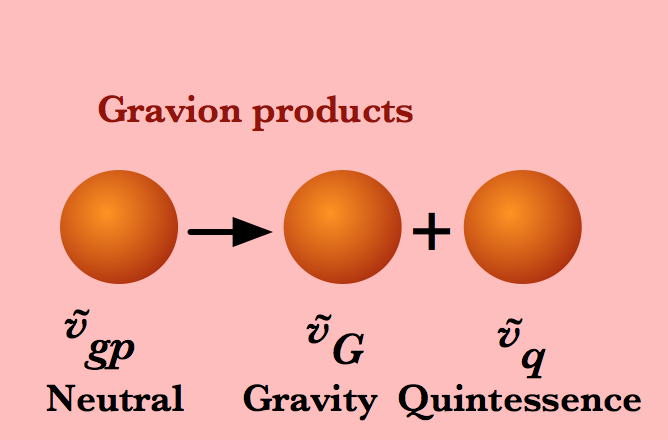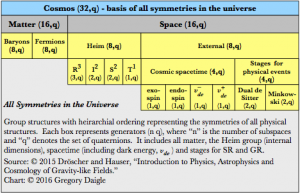In the recent book by Dröscher and Hauser, mention is made of upcoming experiments by Martin Tajmar to test the Heim experiment. Tajmar is the Professor and Chair, Institute of Aerospace Engineering Technische Universitåt Dresden where he has published on a wide range of propulsion-related topics. As such it may be useful to review recent revisions to EHT including the dropping of the gravitophoton, vgp (composed of positive and negative components) as the cause of an attractive and repulsive gravitational effect. Instead, another composite particle is suggested as the source.
In EHT there are three carrier particles for gravitation: the graviton, the gravitophoton and the quintessence particle. Collectively they are known as “gravions.” The graviton for Newtonian gravity is represented in the listing of ordinary matter (OM) as vGN in row H0, and is the boson mediating forces between gravitational fields in the cosmos, “GN” being the indicator of Newtonian gravitation. Its analog in non-ordinary matter (NOM) is the strong graviton, represented in row H1 as ṽG. The tilda (~) above the v denotes an extreme gravitomagnetic or gravity-like field. The bosons with the tilda above (ṽ) are the “cold” or “conversion” particles ṽG, ṽgp, and ṽq which are not generated by mass but by delayed symmetry breaking, similar to the cryogenic symmetry breaking that leads to superconductivity.
The second cosmological gravitational particle is the gravitophoton, designated as vgp. The cosmological version of this gravitational boson mediates the gravitomagnetic field BGN as predicted by general relativity. The cold version of this boson is generated during delayed symmetry breaking when a photon “γ” representing the electromagnetic force becomes an imaginary photon “γI” of imaginary mass but real charge, and converts to the cold gravitophoton ṽgp which decays to produce extreme gravity-like fields.
The decay paths for the vgp cosmological gravitophoton and the ṽgp cold gravitophoton are indicated in the H9 hermetry form. The cosmological gravitophoton decays to a very weak gravitational field via vGN and an extremely small expansion of spacetime denoted by the quintessence particle ṽq, which is shown in hermetry form H10. In short vgp → vGN + vq. The cold gravitophoton decay path ṽgp → ṽG + ṽq does so with gravity-like fields with much greater magnitude due to predicted changes in the gravitational coupling constant.
The third cosmological gravitational boson is termed “quintessence” vq and is responsible for the interaction of dark energy and spacetime. How do the quintessence particles vq and ṽq interact with spacetime? EHT proposes that they are responsible for the interaction between the dark energy field vde and the spacetime lattice, neither of which have hermetry forms but which indirectly causes spacetime to expand.
The cold gravitophoton decay path ṽgp → ṽG + ṽq is the first stage of the decomposition of the cold quintessence particle. It also undergoes a decay to constituent particles ṽq → ṽ+q + ṽ–q. The quintessence particle is thought to be a composite particle make of attractive and repulsive components. The vq boson mediates the repulsive interaction between the spacetime field and dark energy, vde. EHT theorizes that vde is also a composite particle composed of two dark energy component particles (v+de + v–de), one attractive and one repulsive. Each of the components (ṽ+q and ṽ–q), in turn, influences its corresponding dark energy component (v+de and v–de), and this interaction mediates the spacetime lattice producing either an expansion or contraction. As we will see later, this is a likely mechanism for the “parity violation” results observed by Tajmar. See the table below.
It could be said that dark energy is a direct consequence of spacetime. In EHT the formation of the spacetime lattice (negative energy density, possessing information and structure) is invariably accompanied by the formation of the dark energy field (positive energy field, negative pressure) in order to satisfy energy conservation.
Might the interaction between the spacetime field and dark energy which is mediated by the quintessence particle play a role in the distribution of dark matter inside and outside of a galaxy?
According to EHT particles are not observable in de Sitter space (our spacetime) when they possess a negative resting mass. Particles of dark matter are suggested to possess negative resting mass, therefore they must exist in a dual spacetime — a “dual” de Sitter spacetime designated DdS3,1. Those particles of dark matter vdm and vdm are not directly observable by us, but their gravitational interactions with ordinary matter are felt in our spacetime.
The de Sitter spacetime of general relativity (GR) is not replaced, but is extended by the concept of dual spacetime. De Sitter dual spacetime is required to account for the different types of matter that might exist outside GR. The two spaces, de Sitter space and dual de Sitter space, are entangled and share the same spatial coordinates, but are separated by their time coordinates. Dual spacetime also differs from our de Sitter spacetime by employing an imaginary speed of light “i c” as well as an imaginary time coordinate “– i t”. Those imaginary attributes of dual spacetime open avenues to attaining speeds greater than the speed of light (c). This is the “parallel space” referred to in the original award-winning paper by Dröscher and Hauser.
As Dröscher and Hauser suggest in their book, “… dark matter is assumed to be of negative mass existing in the form of a heavy particle with mass mdm approximately -80.77 GeV, and a dark matter neutrino with a negative mass mvdm approximately -3.2 eV.” They continue, “…because of the negative mass of the dark matter particles, they should neither be present in the reactions of the LHC [Large Hadron Collider] experiments, nor be found in any dark matter experiment… since dark matter particles are supposed to carry negative energy and cannot be generated in an accelerator…” EHT forecasts that direct detection of dark matter particles by the LHC and other groups, is impossible.
We know that dark matter appears only in the halo surrounding galaxies, so EHT would have to account for not only dark matter’s presence in galactic halos, but also its lack of detection within a galaxy. However, the attractive nature of dark matter alone would not appear to be sufficient to account for its distribution outside of galaxies. That leaves only attractive ordinary matter and repulsive dark energy to explain the observations about dark matter’s distribution. MOND theory seeks to explain why spinning galaxies do not fly apart. Its proponents posit that Newton’s law is modified for accelerations below 10-10 m/s2. MOND gives the correct value required for this low acceleration value. Can EHT also give an equally correct solution in solving for dark matter? Dark matter appears only in the halo surrounding galaxies, so EHT would have to speculate on not only the degree of gravitational attraction in the halo, but also why it does not occur within a galaxy.
One possibility is that the predicted dual nature of dark energy (attractive and repulsive) may influence the distribution. If dark energy, which causes the accelerating expansion of the universe, is a composite of two particles then how it interacts with normal matter might explain dark matter’s distribution. Assume that dark energy is composed of a repulsive v–de particle causing spacetime expansion and a second dark energy particle v+de causing spacetime contraction. Observed dark energy would be the sum of the two different types of dark energy. How would visible matter within a galaxy interact with the components (v+de + v–de) of dark energy?
It is proposed that Einsteins cosmological constant “⋀” (often considered equivalent to dark energy) is the summation of components ⋀— + ⋀+ where ⋀—, associated with dark energy particle v–de , causes spacetime to expand (positive energy density) and ⋀+, associated with dark energy particle v+de , causes spacetime to contract (negative energy density). Each component may have a large value, but because they are nearly equal (there being a slight expansion of the universe) the difference between the two can be quite small. If the cosmological constant represents the current balance between ⋀— and ⋀+ , then in the present era where spacetime is expanding, the cosmological constant is balanced at ⋀— >0, which means that ⋀+ <0.
It is already known that the acceleration within a galaxy points toward its center, and that it is the same acceleration that exists for all galaxies. One difference within galaxies, as contrasted with intergalactic space, is the density of visible matter. The density of matter (but not dark matter) inside of a galaxy increases by a factor of ten million. The authors postulate that a surplus of v–de particles associated with a slight excess of ⋀— is collected in the halo and, to a lesser extent, inside the galaxy. However, the ⋀+ is neutralized inside a galaxy due to the fact that a galaxy contains a large amount of ordinary matter. Overall this increases the acceleration toward the center of the galaxy may be the basis for the MOND acceleration, one alternative theory to explain gravitational effects around cluster galaxies.

